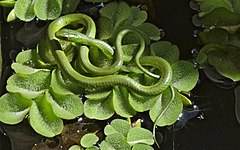Philothamnus
| Philothamnus[1] | |||
| Smith, 1840[2] | |||
 Przedstawiciel rodzaju – Ph. battersbyi | |||
| Systematyka | |||
| Domena | |||
|---|---|---|---|
| Królestwo | |||
| Typ | |||
| Podtyp | |||
| Gromada | |||
| Podgromada | |||
| Rząd | |||
| Podrząd | |||
| Infrarząd | |||
| Nadrodzina |
Colubroidea | ||
| Rodzina | |||
| Podrodzina | |||
| Rodzaj |
Philothamnus | ||
| Typ nomenklatoryczny | |||
|
Dendrophis (Philothamnus) semivariegata Smith, 1840 | |||
| Synonimy | |||
|
| |||
| Gatunki | |||
| |||
Philothamnus – rodzaj węży z podrodziny Colubrinae w rodzinie połozowatych (Colubridae).
Zasięg występowania[edytuj | edytuj kod]
Rodzaj obejmuje gatunki występujące w Czarnej Afryce[6].
Systematyka[edytuj | edytuj kod]
Etymologia[edytuj | edytuj kod]
- Philothamnus: gr. φιλος philos „miłośnik”, od φιλεω phileō „kochać”[7]; θαμνος thamnos „krzak, gąszcz”[8].
- Chlorophis: gr. χλωρος khlōros „zielony”[9]; οφις ophis, οφεως opheōs „wąż”[10]. Gatunek typowy: Chlorophis heterodermus Hallowell, 1857.
- Herpetaethiops: gr. ἑρπετον herpeton „gad, wąż”[11]; Αιθιοψ Aithiops „Etiopczyk, Murzyn”, od αιθω aithō „palić się”; ωψ ōps, ωπος ōpos „twarz”[12]. Gatunek typowy: Herpetaethiops bellii Günther, 1866 (= Chlorophis heterodermus Hallowell, 1857).
- Oligolepis: gr. ολιγος oligos „mały”[13]; λεπις lepis, λεπιδος lepidos „łuska, płytka”, od λεπω lepō „łuszczyć”[14]. Gatunek typowy: Oligolepis macrops Boulenger, 1895.
Podział systematyczny[edytuj | edytuj kod]
Do rodzaju należą następujące gatunki[6]:
- Philothamnus angolensis
- Philothamnus battersbyi
- Philothamnus bequaerti
- Philothamnus carinatus
- Philothamnus dorsalis
- Philothamnus girardi
- Philothamnus heterodermus
- Philothamnus heterolepidotus
- Philothamnus hoplogaster
- Philothamnus hughesi
- Philothamnus irregularis
- Philothamnus macrops
- Philothamnus natalensis
- Philothamnus nitidus
- Philothamnus occidentalis
- Philothamnus ornatus
- Philothamnus pobeguini
- Philothamnus punctatus
- Philothamnus ruandae
- Philothamnus semivariegatus – zaroślowiec cętkowany[15]
- Philothamnus thomensis
Przypisy[edytuj | edytuj kod]
- ↑ Philothamnus, [w:] Integrated Taxonomic Information System (ang.).
- ↑ A. Smith: Illustrations of the zoology of South Africa, consisting chiefly of figures and descriptions of the objects of natural history collected during an expedition into the interior of South Africa, in the years 1834, 1835, and 1836; fitted out by "The Cape of Good Hope association for exploring Central Africa": together with a summary of African zoology, and an inquiry into the geographical ranges of species in that quarter of the globe. Cz. 3: Reptilia. London: Smith, Elder, & Co., 1838–1849, s. ryc. lix i tekst. (ang.).
- ↑ E. Hallowell. Notes of a collection of reptiles from the Gaboon country, West Africa, recently presented to the Academy of Natural Sciences of Philadelphia, by Dr. Herny A. Ford. „Proceedings of the Academy of Natural Sciences of Philadelphia”. 9, s. 53, 1857. (ang.).
- ↑ A.C.L.G. Günther. Fifth account of new species of snakes in the collection of the British Museum. „The Annals and Magazine of Natural History”. Third Series. 18, s. 27, 1866. (ang.).
- ↑ G.A. Boulenger. Descriptions of two new snakes from Usambara, German East Africa. „The Annals and Magazine of Natural History”. Sixth Series. 16, s. 171, 1866. (ang.).
- ↑ a b P. Uetz & J. Hallermann: Genus: Philothamnus. The Reptile Database. [dostęp 2019-04-09]. (ang.).
- ↑ Jaeger 1944 ↓, s. 171.
- ↑ Jaeger 1944 ↓, s. 233.
- ↑ Jaeger 1944 ↓, s. 49.
- ↑ Jaeger 1944 ↓, s. 154.
- ↑ Jaeger 1944 ↓, s. 104.
- ↑ Jaeger 1944 ↓, s. 8.
- ↑ Jaeger 1944 ↓, s. 152.
- ↑ Jaeger 1944 ↓, s. 122.
- ↑ Praca zbiorowa: Zwierzęta: encyklopedia ilustrowana. Warszawa: Wydawnictwo Naukowe PWN, 2005, s. 406. ISBN 83-01-14344-4.
Bibliografia[edytuj | edytuj kod]
- Edmund C. Jaeger, Source-book of biological names and terms, wyd. 1, Springfield: Charles C. Thomas, 1944, s. 1–256, OCLC 637083062 (ang.).
